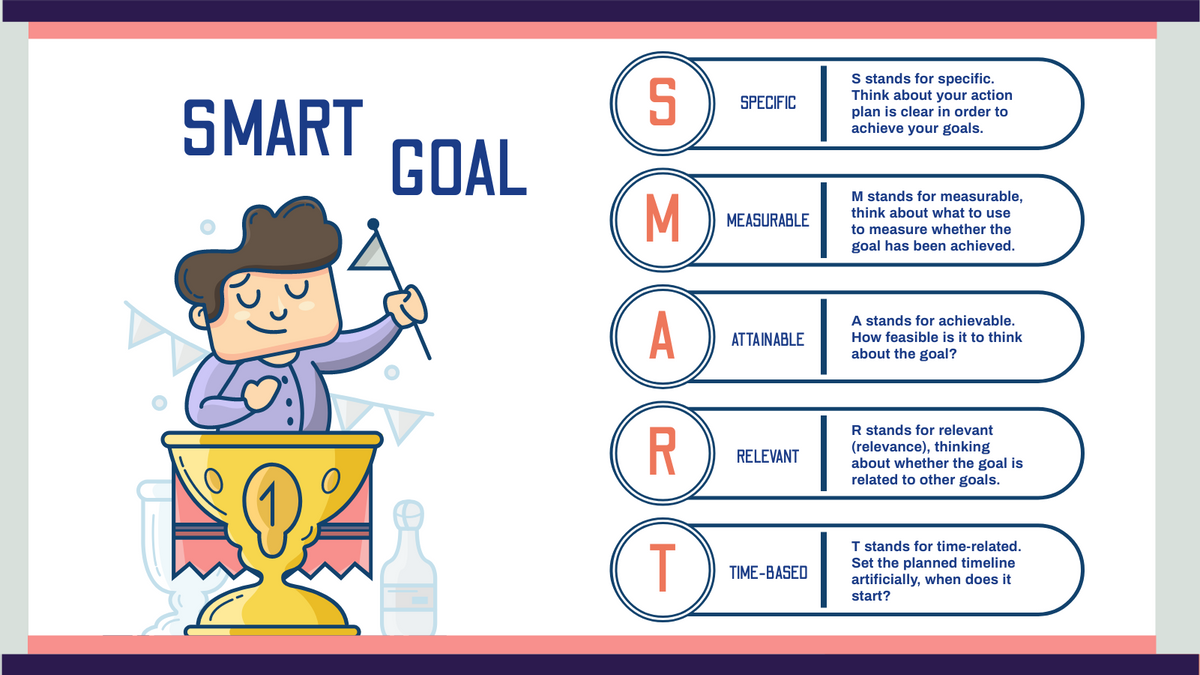Smart Goals Template: Learn How To Write Unique Business And Personal Smart Goals
It's obvious: Goals are essential for personal, professional, and everyday job development. But, as it turns out, we're terrible at establishing goals. According to the Project Management Institute's 2017 research, 17% of projects fail.
In a corporate world full of projects, that's a large amount. Surprisingly, 32 percent of the initiatives in that research that didn't fail outright failed to meet their objectives.
When you add in research from the University of Scranton that showed 92 percent of individuals fail to fulfill their New Year's resolutions, you start to notice a pattern. What is the reason behind this?
Are we putting too much pressure on ourselves to have a goal simply for the sake of having one? Are we not keeping track of our objectives? Is it possible that the objectives aren't clear enough? There are many reasons why teams and individuals fail to meet their goals.
However, many of us establish goals without fully researching and benchmarking them. You may even establish objectives just to forget about them since they were not properly stated. That doesn't imply your efforts were in vain or that you aren't competent in your field. All you need to do now has become SMART about establishing goals.

What Are Smart Goals?
Specific, Measurable, Achievable, Relevant, and Time-bound goals are those that fulfill the five requirements of the SMART acronym: Specific, Measurable, Achievable, Relevant, and Time-bound.
These criteria assist you in clarifying your objectives and establishing limits around them, allowing you to set a high goal while also considering methods to help you accomplish it.

SMART Goals - Quick Overview
Tips To Write Smart Goals
SMART objectives offer a framework that not only allows you to create a quantifiable and attainable goal but also allows you to track your progress. They also eliminate any ambiguity about what should be done, how long it should take, and when you should celebrate reaching your objective.
SMART objectives, in reality, allow you to establish expectations around your achievement and design a route toward achieving it by taking a little additional effort to concentrate on details. When creating SMART objectives, the most essential thing to remember is how to think about the five main criteria as you move through them.
Here's how to utilize each one to create your own SMART objectives.

How To Write Smart Goals Effectively | Lifehack
The Letter S Stands For Specific
There's no question that being precise about a goal and doing the effort to discover every conceivable detail will eliminate any uncertainty that might prevent you from achieving that objective.
Defining the details of your objective can assist you in guaranteeing that it is well-defined, well-intentioned, and clear. So here is your chance to break down the objective and be specific about it.
The questions below may assist you or your team in getting to the details:
- What tasks must be completed?
- What motivates you to accomplish this goal?
- Who is a part of the goal?
- Who is to blame?
- Where will this work be required?
- Is there anything that the work can't do?
Thinking about these questions can help you come up with a more realistic objective that you can act on and share with your team, stakeholders, and management.
The Letter M Stands For Measurable
A well-crafted objective isn't simply clear about what it wants to achieve. It's also simple to calculate. So decide on the best method to monitor and assess your progress.
This may be done by keeping track of the total number of activities, a percentage, a monetary amount, or any other statistic that represents progress toward your objective.
Do you have a hard time coming up with a number? You may want to reconsider your aim.
The Letter A Stands For Achievable
"Go for the gold!" most experts will advise. Setting high objectives isn't a bad idea, but don't get too ahead of yourself. After all, failing to achieve a goal is bad enough, but failing to meet a goal because it was never attainable in the first place is much worse.
This phase is a reality check to ensure that what you've planned is feasible. Examine your objective through a realistic lens to ensure you aren't setting yourself up for failure before you even begin.
That's not simple, particularly if you want to be aggressive but aren't sure whether you'll be effective. Examine all potential restrictions or limits that may obstruct development in order to evaluate your goal's achievability.
These may include the following:
- Workloads and time/availability
- Size of the team: technology/tools
- Budgetary Limitations
- Partners are required, as is associated work.
- There's a lot to think about here to make sure you're on the right track.
The most essential thing is to delve deep and identify any possible dangers or problems. That way, if they do become a reality, you won't be stressed over revisiting the objective.
The Letter R Stands For Relevant
Most likely, you've already mentioned why you're pursuing your objective in earlier stages. However, here is your chance to thoroughly explain why the objective is essential to you or your company.
Identifying a key result clarifies why you're working and how it will help you, your project, or your company. Having that one guiding light also aids you in making choices and adapting to change as your job progresses.
The Letter T Stands For Time-Bound
Goals, like most undertakings, have a certain time limit, and if you miss it, you've failed. Many external variables, such as linked projects, events, and teams, may have an effect on goals.
That's why it's a good idea to establish a timetable for achieving your objective. This not only makes your objective quantifiable and achievable, but it also keeps it practical.
It also puts everyone on the same page about what has to be done and when. Here's the thing: given a little more time, you can probably achieve most of your objectives.
But if you can't accomplish it in a certain amount of time, you may be focusing on the incorrect methods to achieve your objective. Having a time limit on your objective encourages you to work harder and be more inventive with your methods.
How Do You Write A Smart Goal
A smart objectives worksheet is very flexible since it can be used for a variety of purposes while still fitting on one page of the paper.
Here are some guidelines to help you create your own smart goal format:
Your Goal
This is where you describe what you want from your objectives in the simplest words possible. Your objectives should be no more than two to three lines long, and contain what you want to achieve as well as a deadline.
The Importance Of The Goal
Take this as your own reality check. Most individuals establish unrealistic objectives that they want to reach but are unwilling to put out the work required to achieve them.
Explain why the objective you've chosen is significant and something you wish to pursue in this section. Try not to establish too many objectives for yourself, since this will make achieving them all too difficult.
Your Smart Goal Checklist
This is the heart of the SMART process, and it's what sets the actionable SMART goal worksheet apart from all the others. Make careful to evaluate your objectives for each stage of the SMART process as you move through these processes.
If the objective you came up with in the first stage, for example, fits the requirements on the checklist, you may tick the appropriate box before moving on to the next step. If it doesn't fit the requirements, make some changes before continuing.
Identify Any Potential Complications Or Issues
This is a crucial part as well. Many people fail to achieve their objectives because they do not consider the problems they may face. Remember that any objective may have a few roadblocks that may throw you off course.
Having these possible difficulties, complexities, or problems written down can keep them fresh in your memory, allowing you to avoid or deal with them when they occur.
The Target Completion Date
This is the second part in which the significance of the completion date for your objective is discussed. You will reinforce your objective and the deadline you have set for yourself by giving this date.
Create A List Of Actionable Steps For Your Goals
Some objectives are straightforward and may not require any active action. Other objectives, on the other hand, are more complex and may require greater preparation from the start.
These actionable actions, in particular, are those that you may delegate to others. You may also make your objectives more attainable by doing so.

How to Write a SMART Goal
How To Set Smart Goals With A Template
There are two methods to set SMART objectives. You may make a document and establish objectives by writing them down on paper or digitally in a doc, to-do list app, task management software, or note-taking app.
You may also make use of a free SMART goal template. It will assist you in developing a realistic action plan for mapping and tracking your personal and professional objectives.
Guidelines and suggestions on how to create and accomplish SMART objectives are typically included in the templates. If you're new to this kind of goal-setting, it won't be tough for you. Here are the finest templates for creating SMART goals, achieving them quickly, and doing whatever you desire!
SMART Goals Templates, Example & Worksheets From Templatelab
Every design includes a worksheet form to help you better establish goals and ensure you're working on realistic goals. Every SMART objective includes a brief explanation of the most essential concepts, rules, and recommendations to help you understand what you're trying to accomplish.
You may choose from a variety of templates, including ones for workers, students, instructors, salesmen, and job and project management.
Using TemplateLAB's SMART goals templatewill provide you with a clear framework for establishing and maintaining your objectives.
S.M.A.R.T Goals Template From University Of San Diego
This is a basic SMART objectives template that can assist you in prioritizing activities and developing an action plan for your job, company, or personal life.
It's ideal for individuals who are just getting started with goal-setting or who need a basic template for determining meaningful and time-bound objectives.
SMART Goals Template For Word And Google Docs
It'll be ideal if you're searching for a simple SMART objectives template for Word or Google Docs. This PeopleGoal template assists you in defining a single goal and expanding on it using the SMART attribute to make it precise, measurable, attainable, relevant, and time-bound.
You may also keep track of your SMART goals' progress, identify barriers and the help you'll need to achieve them, and set quantifiable milestones.
SMART Goal Template Smartsheet
The Smartsheet SMART goals template is a free, clear, and simple example of how to create objectives. It has many questions that can assist you in putting down your goals. Furthermore, the thorough guide will provide you with actual examples so that you may move toward achievement.
SMART Goal Template For Hubspot
The form of This SMART goal may be used to create marketing goals. Worksheets for creating, calculating, and assessing your SMART objectives are included. It's a fantastic SMART objective template for creating precise, time-bound marketing strategies.
The template is split into three parts (Define, Calculate, and Evaluate), which will guide you through the goal-setting process and ensure that you meet your goals.
It is, however, a more sophisticated worksheet designed for marketing professionals who know what statistics they want to see in monthly traffic or conversion rate.
Brian Tracy's SMART Goals Chet Sheet
Brian Tracy is the author of many books, including Earn What You're Really Worth, Eat That Frog!, and No Excuses! He explains how to utilize SMART objectives to retain willpower and accomplish achievement in personal and professional tasks on his blog.
His free template includes step-by-step instructions on how to create SMART objectives. There are additional examples and extra activities to help you plan and accomplish your goals.
Onplanners' SMART Goals Templates
planners provide printable goal-setting forms in a variety of formats, all of which may be downloaded in pdf format (and if you have more than one file, use PDF combiner).
You may pick from a variety of colorful or black-and-white sheets. You'll also discover additional templates on the internet, including daily, weekly, and other planners, habit trackers, to-do lists, calendars, and more.
You may use them to monitor progress and keep all of your tasks on track as a complement to your SMART objectives template.
